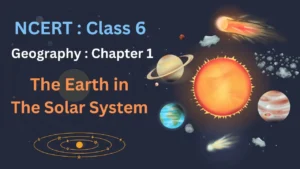
The earth in the solar system
Celestial Bodies :- The sun, the moon, and all those objects shining in the night sky are called celestial bodies.
Star :- Stars have their own heat and light.
Constellation :- Patterns Formed by different groups of stars.
Example :- Saptarishi(Group of 7 stars). Ursa major and Big bear is a constellation.
Planets :- Taken from the Greek word Plantei it means wanderers.
Solar system :- Sun + 8 Planets + Satellites + Asteroids + Meteoroids
Note:-
Geo + Logy → Study of the earth
Geo + metry → measurement of the earth
Geo + Oid → resembling the shape of the earth
Sun:- It is a star. 150 million km away from the earth.
Planets :-
- Mercury :- Nearest to the Sun
- Venus :- Earth’s Twin, Hottest Planet
- Earth :- Third nearest to the Sun, Fifth Largest,Blue planet
- Mars :- Red planet
- Jupiter :- Largest Planet
- Saturn :- 2nd Largest
- Uranus :- Coldest
- Neptune:- Farthest from the Sun
Jovian Planet :- Jupiter, Saturn Uranus,Neptune these 4 planets known as Jovian Planet.
Astronomy :- study of celestial body
Earth :-
- Shape:- Geoid
- Distance between earth and moon:- 3,84,400km
- The moon is the closest celestial body of the earth.
Moon:-
- The moon moves around the earth in 27 days and also spins in 27 days.
- Only one side of the moon is visible to us.
- Neil Armstrong:- first man to step on the surface of the moon on 20 July 1969.
Satellite :- A satellite is a celestial body that moves around the planets in the same way as the planets move around the sun.
Asteroids :- Tiny body which moves around the sun.
Meteoroids :- Small pieces of rocks that move around the Sun.
Milky Way :- Cluster of millions of stars.
Galaxy :- system of billion of stars, Clouds of gases and dust
Universe :- Million of Galaxies
Note :- Speed of light:- 3×10^8 m/s
